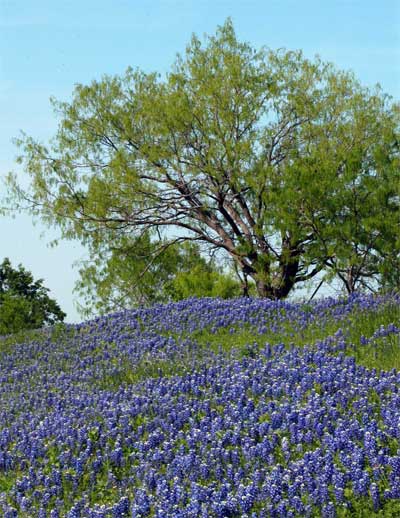Bluebonnets and Better Times

It was probably 35 years ago. I asked my good friend the late Benny Simpson why almost all native Texas plants have incredibly tough seedcoats. It seems like you have to scratch, scrape, file or freeze every last one of them before it will germinate. "Why is that, Benny?" I asked.
His simple reply: "Neil, if every native plant had a soft seedcoat, they’d all try to germinate after the first good shower. Then, if a major drought came along, they’d all die, and we’d be left with no plants." And, then Benny went out to try to get his bluebonnet patch behind the research center to germinate.
So, I jump ahead by 10 or 12 years, and Dr. Jerry Parsons (Texas Agricultural Extension Service, as it was called in those days) of San Antonio was found doing research on bluebonnets, trying to isolate and replicate a red strain so that he could plant a red, white and blue Texas state flag for the state’s sesquicentennial celebrations in 1986. That had been a promise he made to our friend Carroll Abbott (Green Horizons, Kerrville). Carroll probably knew Jerry would accomplish it, but unfortunately, our mutual friend didn’t live long enough to see Jerry’s results.
As he was studying bluebonnet colors, Jerry also was seeking a way to get bluebonnets to germinate more reliably/rapidly. Somewhere in there, he began working with John Thomas, founder and visionary person behind Wildseed Farms in Fredericksburg. Everyone had tried freezing and abrading the seeds, but results were still sketchy. They discovered that the seedcoats could be acid-etched with a bath of sulfuric acid (very dangerous – do not try this yourself). Those seeds germinated at a very high percentage, and they sprouted very quickly.
So, that’s where our story picks up with your planting acid-scarified bluebonnet seeds in late August or early September for bloom come next spring. Wildseed Farms recommends planting into neutral or slightly acidic soils if you can. Sandy or gravely soils work best, as they ensure good drainage. Avoid extremely fertile garden soils, however, or you may end up with lush plants and minimal flowers. (Remember that they’re nitrogen-fixing legumes.)
It’s best to plant bluebonnets where they will not have to compete with turf or pasture grasses. Rototill the soil lightly (1-3 inches) and rake it to a smooth grade. Wildseed’s website (http://www.wildseedfarms.com/) recommends planting at the rate of one ounce per 78 square feet. That equates to approximately one pound per 1,200 square feet (30- by 40-foot area). Rake the soil gently with a leaf rake or a garden rake turned upside-down to cover the seeds, then water to soak the ground.
The small bluebonnet seedlings will begin appearing within 2 to 3 weeks. Keep the soil moist, but not soggy wet as they are germinating and growing. As temperatures cool down, their top growth will slow. However, the roots will be establishing over the winter, and as warm weather returns in February, the bluebonnets will spring forth and begin setting buds.
Allow your bluebonnets to finish flowering completely. In 4 to 6 weeks, the plants will turn brown as the seedpods mature. When the pods rattle with loose seeds inside, it’s time to mow the area. Set your mower to a fairly low speed, and let the mowed stubble distribute evenly over the same area. Your seeds will be resown for the following year. They won’t be acid-scarified, but you’ll have enough of them that you’ll always have a nice rebloom (even without retilling) if you’ll just keep the area moist in early fall and through the winter.

